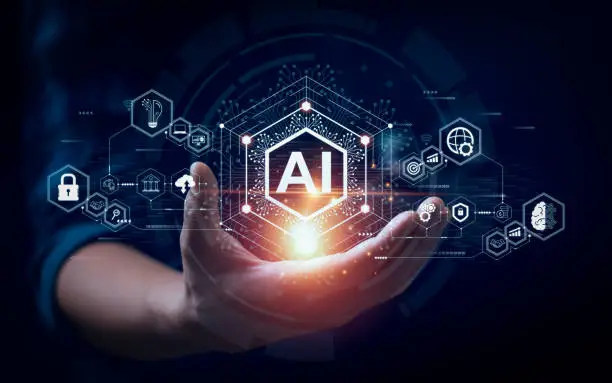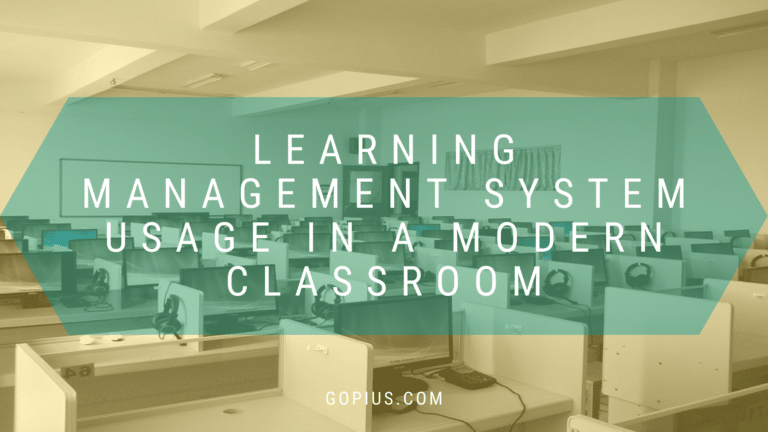The AI Revolution in eLearning

The AI revolution in eLearning is here to stay and it will be a hot take for years to come. The way we learn online is changing a lot because we are using Artificial Intelligence (AI) more and more. AI is changing eLearning in many ways. It is used to make learning personalized for each person and to create content with the help of AI. In this AI-focused era of eLearning, there will be large-scale language translations and the rise of AI-generated virtual presenters.
AI in eLearning has improved a lot in recent years. Smart computer tools have become really popular, especially for making content and pictures. Big technology companies, such as Microsoft, are working together with OpenAI to create very smart computer programs called algorithms that can think and act like humans. These amazing efforts have resulted in new technologies like the “Generative Pre-trained Transformer” (GPT), which is also known as ChatGPT, and DALL·E, a tool that can create graphics and images using AI. Another AI tool that is important in the field of eLearning is Google’s Bard. This tool has a lot of potential for making learning better.
These AI tools are being introduced to completely change how eLearning content is made. ChatGPT and Bard can create detailed eLearning materials, which is a new way to make content. However, DALL·E’s use of images has the potential to create engaging educational experiences that are visually captivating.
In addition to these new ideas, creators of online learning materials are using AI-based tools like Jasper, Copysmith, ShortlyAI, and Frase more and more. These tools help make it easier to create short and long educational content, which gives more options for eLearning.
Furthermore, the combination of Natural Language Processing (NLP) tools, like chatbots, is slowly changing eLearning help systems. NLP algorithms are changing how people use eLearning platforms. They help employees when they start their job and provide tools for better performance and learning, like voice-activated features.
As artificial intelligence keeps improving, there is a lot of potential for the future of online learning. Personalized learning experiences, content created by artificial intelligence, and smooth language translations are only a small part of what can be achieved. Adding artificial intelligence to online learning is allowing students to learn and gain skills in new and exciting ways.
Also read: Virtual Training: How to Increase Engaging Sessions through these 7 Tips
Advantages Of AI Revolution In eLearning
The use of AI in online learning has many advantages for students and education teams. These advantages include:
Creating content that is optimized
Creating content that is optimized means making sure it is designed and structured in a way that improves its performance and visibility on the internet. AI algorithms use Natural Language Processing to make content creation better. This helps to make sure the content matches how learners are doing and what they like.
Faster creation of content:
AI helps us create content faster and makes it easier for L&D teams to create and update eLearning materials.
Improved way of teaching and sharing knowledge
Artificial intelligence tools help teachers in different ways, like giving better tests, finding out what students like and don’t understand, and giving interactive and smart teaching support. This results in better eLearning experiences being given.
Making the learning process more interesting and encouraging active participation from learners
AI-enabled virtual tutors and chatbots are tools that help learners by giving them immediate and tailored assistance and advice. This not only makes people more interested but also increases learners’ desire to learn. Furthermore, AI can create interesting content such as pictures and videos, which helps to make learning more exciting.
More understanding
AI-driven algorithms analyze information about learners, such as their preferences, test scores, and how engaged they are. This gives L&D teams important information about how well eLearning programs are working, so they can use the data to make better decisions for making them even better.
Customized study materials
AI can create personalized flashcards, quizzes, and summaries to help each learner with their specific needs and preferences.
Round the clock availability
Virtual learner assistance means that help is available online for people who are learning something. AI-powered tools like chatbots and virtual assistants are available all the time to help learners. They provide help whenever it is needed and offer learning support whenever it is necessary. These tools help with learning when and where it is needed. They also have applications that support performance.
By using AI technology, eLearning becomes better with customized experiences, faster content creation, and ongoing assistance for learners. This amazing technology helps teachers and students to reach their learning goals better in the digital age.
Growth And Adoption: The Current State Of AI In Relation To eLearning
AI is becoming more important in making online learning better, especially as more people start working from home and using technology to learn. Here are some important things to know about AI in eLearning right now:
AI Skills Are In High Demand
Artificial Intelligence and Machine Learning are in high demand in the tech industry. There is a high demand for experts in AI technologies like; AI Art Generation, ChatGPT, Amazon EMR, Midjourney and Azure Machine Learning. This shows that AI is becoming more important in eLearning.
Content Production Should be Rapid
AI tools have changed the way we create learning materials by making it faster. eLearning design and development teams can use AI tools to make content fast, which helps make the process of creating and improving content more efficient.
Learning Experiences Needs Personalizing
Artificial intelligence (AI) algorithms can customize learning material to match what each person needs. AI uses data from learning and content management systems to make learning better. It changes the content to fit what learners like, what they don’t know, and how well they are doing.
Optimization for Learning Delivery
AI algorithms use data analysis to make eLearning experiences better. AI can use a lot of learner information to find patterns, trends, and useful information. This can help make learning more effective. This method that uses data makes learning better for people.
AI Integration Into Learning Management Systems
Artificial intelligence (AI) is being included in Learning Management Systems (LMSs) and other eLearning platforms to make them work better. Technology is being used to make learning more customized and interesting for students. This includes things like giving personalized suggestions, adjusting tests to match a student’s abilities, and creating individual learning plans.
Data Analysis Breeds Continuous Improvement
When AI is used in eLearning, organizations can collect and study a lot of information about how learners are doing, how interested they are, and what they prefer. This method helps organizations that prioritize learning to use data to improve their decisions. It helps them find ways to improve the content and delivery of their work.
Manners Which AI Can Transform eLearning Content Development
AI can change and improve the way we create eLearning content by using new and more efficient methods. It provides many helpful advantages, like using AI tools to create content, including text, pictures, and videos. This saves time and makes work easier. Artificial intelligence-powered computer programs like chatbots and personal assistants can make learning more interesting and offer individualized help.
Artificial intelligence (AI)-powered tests and quizzes change according to each person’s data, giving them a personalized testing experience. AI makes it easier for people to access information by creating summaries and helping them learn in a way that suits their needs. It helps change courses to fit different places and languages by doing the translation and localization work automatically.
Artificial intelligence (AI) technology can make educational content, like games and simulations, more interesting for learners. AI-generated images and videos are helpful additions to course materials. Lastly, automation allows developers to concentrate on more important tasks. This makes things work better and improves eLearning experiences.
Learning With AI Transforms eLearning Delivery Through 5 Easy Ways
The use of AI in online learning will greatly change how it is taught and customized. Here are some important ways that AI will change the way we learn:
Personalized and Adaptive learning tools
AI-powered adaptive learning tools use data and behavior information to make learning experiences personal. The courses and content will be changed to fit the needs, likes, and progress of each student, to make their learning experience better.
Effective and immersive eLearning strategies
AI will improve eLearning methods like learning through mobile devices, breaking content into small parts, and making it more engaging by incorporating game elements. Artificial intelligence tools will make these strategies more captivating, interactive, and interesting, leading to improved learning results.
Chatbots and virtual assistants
Virtual assistants and chatbots that use AI will give learners immediate help and guidance, which will make learning easier to access and save trainers’ time. Students can get quick answers to their questions and individual support as they learn.
Accurate tracking of assessments and progress
AI algorithms will make it easier for people to accurately assess and evaluate themselves. AI-powered tools can analyze how learners are doing and give detailed feedback on what they are good at, what they need to work on, and how they can improve.
Data-driven decisions for analytics engines
Artificial intelligence technology will use the large amounts of data from Learning Management Systems and learning experience platforms to analyze and understand information. These engines will find important information, like what people like to learn, what they still need to learn, and what they struggle with. This information will help L&D teams make smart choices to keep getting better.
Enhanced efficiency of course development
AI tools such as ChatGPT and DALL·E can help speed up course creation by making detailed text and impressive visuals for story planning. Fast tools for creating courses can be used to make these AI-created things come to life, making very effective and realistic online courses in a short amount of time.
The Future Of AI within eLearning
The use of AI in eLearning will bring fast content creation with the help of AI, improved personalized learning, and engaging learning experiences. AI tools will make different types of learning materials, like Virtual Reality, simulations, Augmented Reality, and learning games. Students will gain advantages from personalized materials, adjustable evaluations, and customized learning routes.
AI will find areas where people need to learn more and help them improve at the right time. Teachers will get help in making learning better by checking how stressed, focused, and interested students are. The combining of AI with Virtual Reality, Augmented Reality, and Extended Reality will make very immersive experiences.
AI will make it easier to create SCORM-compliant eLearning. Machine Learning and deep learning will improve the adaptive algorithms and data analysis. In the coming years, there will be big improvements in eLearning. It will become more personalized, interactive, and efficient. Learners will go on exciting journeys with the help of AI technology.
Cautionary Considerations
If we don’t monitor how we use AI, it could stop people from thinking for themselves when they make things, like writing or creating content. This could cause problems like copying other people’s work, breaking copyright laws, and other ethical issues.
Moral issues can also come up when computer programs create false or deceptive information, and when people’s personal information is used in a way that may not be fair. This includes thinking about privacy, as well as who owns content that is made by artificial intelligence. We need to be careful and follow ethical rules to make sure AI is used responsibly and for the betterment of eLearning.
Summary
Using AI in creating eLearning content has great potential to completely change how courses are made. As the year goes on, we expect more people to use artificial intelligence (AI) for personalized learning and automatically created content. Some examples of how this technology can be used soon include translating languages on a big scale, having virtual presenters created by artificial intelligence, and making videos.
AI-generated content makes it easier to personalize and customize courses on a large scale. But, it is very important to find the right amount of AI automation and human involvement. We must make sure that people’s needs and requirements are important in how we learn and create value for both learners and businesses. This means involving people in the process of developing AI-generated content.







